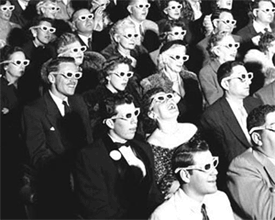 Bruce Wade is the Editor of International Express. In the first of three blog articles, he considers how and why video should be used in the ELT classroom of today.
Bruce Wade is the Editor of International Express. In the first of three blog articles, he considers how and why video should be used in the ELT classroom of today.
This is the era of video. YouTube serves well over a billion views a day worldwide, sales of DVDs are booming, and the technology is developing rapidly with high definition flat screen TVs, Blu-Ray and 3-D.
When video was first made available, all we had was a big video player and an enormous TV with lots of wires and plugs. But the way we watch video is constantly changing; now we have PCs, laptops, broadband, flat-screens, DVD players, handhelds the size of our palms, and so on. Video is also making a return to mainstream language teaching as we enter a new phase of lower production costs and improved access to digital material in different formats. In the classroom, teachers can exploit the material in various ways.
Using Flash, visual images can be packaged with interactive exercises, subtitles, and other resources to make up a full learning experience. Students can watch video footage and cut backwards and forwards between the video, the exercises, and a wordbank so that they can listen, learn new vocabulary, check they’ve understood, or repeat if they haven’t. They can control their learning experience and tailor it to their individual needs.
Teachers need to ensure that video adds value to a student’s learning experience. A good worksheet that guides the class through the video, highlights thematic points of interest and useful vocabulary, and provides a variety of engaging activities, ensures students feel that video is a valid and effective teaching and learning tool.
Video is arguably the best medium for language learning and teaching. It combines a visual context with spoken language, and in many cases, written text in the form of subtitles.
The visual element has numerous benefits. It brings the outside world into the classroom. It provides visual clues which work in their own right and support the spoken text. We can see people’s facial expressions, their body language, and the physical background. Visual images provide a greater stimulus than simple auditory input. Seeing someone jumping off the edge of a 1000-metre cliff will stay in the memory longer than someone talking about it.
International Express Video: Elementary level, Unit 10: Berghaus
Visual images help to convey meaning. Seeing the inside of a real warehouse with fork-lift trucks, conveyor belts, and people packing is a more effective way to learn those terms than using translation, definitions, or explanations.
Video is also by its nature entertaining. Most people enjoy the visual medium, which requires less effort on the part of the viewer than listening or reading. There is also the potential in video to use stills, for example, maps, photos, close-ups, graphs, etc. in combination with moving images to create variety, and to give students a chance to reflect on what they have just learnt.
Read Bruce’s second blog article in this series , entitled ‘The use of reportage and mini-documentary’.


Teaching with video is the best way to really show students a varied way of learning English. Oxford, YouTube and any other method of teaching creates a positive learning environment that all students like and appreciate. Teachers who aren’t using video as a teaching resource are really behind the times. We have been using video and interactive programs over the past year and a half with great success at Larisa School of Language, Nikolaev Ukraine.
using video as a teaching resource is fantastic because you can capture children`s attention and work easily with different learning styles.
I have been teaching English and History to the 12th grade and 10th grades respectively.Using videos in the classroom to teach English has been really fun and enjoyable for the class. I am using clips from different movies to heighten the experience of learning. Since I have been watching English movies since my childhood.
It has been a very satisfying experience since the last 6 years that I have been using this methodology.
A teacher who is not using this is keeping the taught far from this wonderful experience.
T. Rahman
(PGT English)
St. Gabriel’s Academy,
Roorkee (India)
It´s the best for our students´classes , we can do everything easier for them.
I agree with all of you.
To learn English as a foreign language in a developing country where many students don’t feel the target language as a need for their life, we, teachers, have to find ways to make our teaching more interesting and appealing to our students and videos are the way the world goes for young learners.
I have started using videos in my classes because they can do more for learners than explanations (as in dictionaries) and translations. This is really the way we think of something on your minds: we listen to a word or sentence, we design it, that is, we form an image of this word or sentence in mind, then we make this image more real for us rather than only a concept (almost something we can touch or grab). For a child, this bridge (from objective to subjective) becomes shorter. The principle is: the more we can form pictures in mind, the more (and faster) we understand and, for language learners specifically, they become easily able to get started to use new vocabulary or new expressions for instance.
I usually use animations and sitcoms scenes during my classes in order to show learners playful learning and real-life situations in English.
[…] Taken from Oxford University Press ELT Global Blog […]